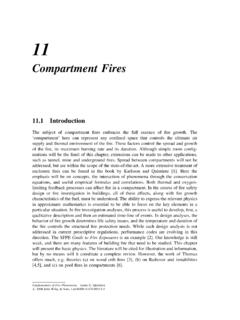Transcription of The Heat-Kit Planning Guide
1 Printed on 8/25/2010 The Heat-Kit Planning Guide Masonry heating 2 What s a Masonry Heater? 2 The Benefits of Radiant heating 3 Environmental Benefits 5 The Heat-Kit system 7 Introduction 7 Description 7 Components 7 Gas flow 8 Technical Features 9 Options 10 Domestic Bakeoven 10 Domestic Hot Water 11 Layout Guide 15 Standard dimensions 15 Clearances 15 Heater 15 Chimney 15 Layout Examples 16 Heated Benches 16 Examples of high output systems 18 Completing Your system 19 Working with a local mason 19 Foundation plans 20 Frequently asked questions 21 Finding More Information 23 Our Products and Services 24 Products 24 Services consulting and design 24 Costs 24 Masonry Stove Builders Norbert and Leila Senf, proprietors Voice Fax e-mail RR 5, Shawville, Qu bec J0X 2Y0 Visit our website at The Heat-Kit Planning Guide 2 Masonry heating What s a Masonry Heater?masonry heater allows you to heat your home with wood in a unique way.
2 It s main distinction is the ability to store a large amount of heat . This means that you can rapidly burn a large charge of wood without overheating your house. The heat is stored in the masonry thermal mass, and then slowly radiates into your house for the next 18 to 24 hours. You get a number of benefits, described in more detail below. If you burn wood fairly rapidly, it is a clean fuel. If you try to burn it too slowly, the fire will change from flaming to smoldering combustion. The burning process is incomplete and produces tars. Atmospheric pollution increases dramatically. This is important if you are Planning an energy-efficient house. The average energy demand of your house will be quite low. For most of the time, it may require only 1 to 2 kW of heat . For most conventional woodstoves, this is below their critical burn rate , or the point where they start to smolder. In other words, woodburning and energy efficient houses don t really suit each other very well, unless you have some way to store heat so that your stove can operate in the clean range all of the time.
3 Masonry heaters fill the bill perfectly. If you need even a very small amount of heat , such as between seasons when you simply want to take off the chill, you simply burn a smaller fuel charge yet you still burn it quickly. The large surface is never too hot to touch. You have a premium radiant heating system with a comfort level that simply cannot be equaled by convection or forced air systems. A The Heat-Kit Planning Guide 3 The Benefits of Radiant heating asonry heaters are radiant heating systems. Radiant heating differs in sev-eral fundamental aspects from conven-tional convection and forced air heating . Understanding these differences is important if you plan to include a masonry heater in your house design. Why do we heat ? A good approach is to ask the question Why do we heat ? . While this may seem trivial, it's important to consider the fact that our body produces its own heat , about 100 watts when we're resting.
4 Strictly speaking, we don't need to heat our bodies at all. Rather, we need to prevent them from losing heat . We exchange heat with our surroundings through two main mechanisms: radiation and convection. The proportion of each varies depending on how you are dressed and on your environment. In a T-shirt in an average house in the winter, you're losing about 60% by radiation. The exact amount can vary dramatically depending on what surface temperatures your body sees in surrounding objects. A good example: When you are outside in the spring on a calm, sunny day, you can wear a T-shirt even though the air temperature might be 55 or 60 F. But step into the shade and you will start shivering within several minutes, even though the air temperature hasn't changed. The presence or absence of the sun changes your radiant environment dramatically. Similarly, even a slight breeze at these temperatures would change your convective environment.
5 The word "draft" in this context immediately conjures up mental images of discomfort. Radiant heat is electromagnetic energy, the same as visible light. The only difference is that it is in the infrared range of the spectrum, with a longer wavelength. Long wave infrared is more com-fortable than short wave infrared. As the surface temperature of a radiating body gets higher, the wavelength of the radiant energy gets shorter, until eventually it is seen as a dull glowing red. This is the piercing heat you feel from a campfire as you get close to the charcoal bed. Air temperature less important With radiant heating systems, the concept of air temperature assumes less importance. This is a key point. Our conventional model of heating and com-fort is based on forced air heating systems, where air temperature is all important: you need a thermostat that can regulate the air temperature to within a couple of degrees. To understand what really happens, we need to add another parameter to our model: mean radiant temperature, or MRT.
6 This is simply the average surface temperature of all the walls in the room, including the approximately 100 sq. ft. surface of the masonry heater. The chart on the left shows what happens: As the MRT rises, the "comfort band" of air temperatures widens dramatically. This helps to explain why a masonry heater doesn't need a thermostat. It also explains why your glass patio doors need a curtain at night, even though the curtain is not reducing heat loss substantially: The curtains have a higher surface temperature than the cold glass, particularly with a radiant heat source. MFigure 2. Radiantly heated rooms are comfortable over a wider range of air temperatures.(temp. is in Fahrenheit degrees) The Heat-Kit Planning Guide 4 Other aspects of radiant heating systems Less dust With a conventional forced system , you use the air that you breathe as a heating medium by cycling it through your furnace blower every few minutes.
7 When you wake up in the morning with a parched throat , you associate this with dry air. In fact, it is not dry air at all, but dust. The furnace circulates very fine dust throughout your house. Furnace filters only get the larger particles, not the very fine dust that causes the most sensitivity. When you add a humidifier, what you are actually doing is using moisture to help settle the dust out of the air. Consider this: For a person with respiratory problems, where is the best place to be in the winter? Answer: Arizona, where the air is dry. Less stratification The reason there is less air movement with a radiant heating system is that there is a much smaller temperature difference between the air at the ceiling and at the floor. There is less overheating of upstairs bedrooms, and ceiling fans can usually be eliminated. Radiant heating gives you more mileage from a given amount of heat output by targeting it better to where it is needed: in the living space where the radiant panels are located.
8 Healthy heat Radiant heating is beneficial for many allergy and respiratory related problems, for the reasons outlined above. In addition, you experience comfort at a lower air temperature. Cooler air next to your exposed skin promotes circulation and your body's own heat production. It feels invigorating and allows you to be more alert. The sunny spring day cited earlier demonstrates this effect. In Europe, radiant heat has been used in medicine for therapeutic purposes for many years, and it is starting to see some use here as well. How does this affect my choices? Location important Understanding some of the basic principles of radiant heating is important when you decide where to locate your masonry heating system . Generally speaking, a masonry heater creates a comfort zone around itself. The closer you are to the heater, the higher is the MRT that your body sees in its environment. This means that you want the heater located where your family spends most of its time.
9 An open floorplan and a central location work best. Often the masonry structure is designed to serve as a space divider between, say, kitchen and living room. The fact that only minimal clearances to combustible materials are usually required allows for greater flexibility in integrating the system into the home. Also consider the location of the firebox loading door and its convenience to your firewood supply. Firewood storage inside the house is often not necessary, since the firebox gets loaded all at once. Many heaters often do double duty as fireplaces, so this function should be considered as well. Windows affect performance Many modern windows come with a special low-E coating that acts like a mirror for longwave radiant energy. With a masonry heater in the room, your body sees a reflection of the room s warm surfaces in the window in addition to the cold surface of the glass itself. With large, uncovered glass surfaces such as patio doors, low-E glass will improve comfort levels noticeably with vertical radiant panels such as those in a centrally located masonry heater.
10 The Heat-Kit Planning Guide 5 Environmental Benefits A sustainable technology ustainable construction is starting to come into its own. Many people are beginning to question not only the energy consumption of their houses and their lifestyles, but also wider effects, such as the amount of embodied energy in the house materials, and the amount of pollution that has been generated as a result. Masonry heating is an ancient technology. Its basic ingredients are earth and fire. While it is relatively new to North America, it dates back several hundred years in many of the colder regions of Europe. All of the materials in a heater can be recyclable, if desired, and there are heaters in Europe that have been giving faithful service for over a hundred years. Helping to reduce global warming The most important global environmental issue today is global warming and our emissions of greenhouse gases (mainly carbon dioxide).






